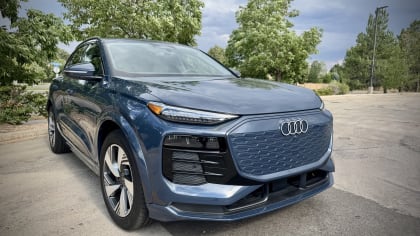GOING ELECTRIC
Living in the electric car world
This article is from our archives and has not been updated and integrated with our "new" site yet... Even so, it's still awesome - so keep reading!
Published on Sun, May 26, 2013
By: The LACar Editorial Staff

By Roy Nakano
You don't need a weatherman to know which way the wind blows. - Bob Dylan
When Bob Dylan took out his Fender Stratocaster to play an electric version of "Maggie's Farm" at the Newport Folk Festival on July 25, 1965, the reception was anything but warm. On the contrary, the folk music audience was in shock. By the time he played his electric version of "Like a Rolling Stone," the festival-goers were booing, prompting Dylan to walk off the stage. On that day, history was made, and neither folk music nor rock 'n roll would ever be the same.
Today, the public reception to electric cars has some interesting parallels to that day in 1965. A vocal segment of the editorial press has been trying to boo the electric car off of the automotive stage. The reasons range from government heavy-handedness (“why should my tax dollars subsidize your purchase of an electric car?”), to questionable cost benefits (“you’ll save more money buying a Nissan Versa”), to range anxiety itself.
On the virtues of government incentives for alternative fuel vehicles, we’ll leave that for the political pundits to wrassle over. On the issue of cost-effectiveness, a fuel efficient but very used beater will beat out any new car in that department. The long and the short of it is this: Electric propulsion is a luxury. Like the buyer who’s willing to spend the extra dough for turbocharged acceleration, or for a convertible top to take in the surroundings on a star-studded evening, electric propulsion is a premium to pay for. But as luxuries go, there’s nothing quite like the experience of driving in utter quietness, propelled by an electric motor with full torque available at zero revolutions per minute.

Life is just a little different
Having lived with a 2013 Chevrolet Volt in its fleet since October, we can report that life is just a little different with an electric car—even with the so-called “extended range” design of this model with the back-up gas motor. While the car goes well over 300 miles in its back-up gas motor mode, you really want to keep it in pure electric mode for the best driving experience. Consequently, it’s not unusual to find yourself leaning towards traveling near rather than afar. Suddenly, that restaurant in the neighboring township looks a lot more attractive than the popular hangout on the other side of the city. Going electric means you’ll be supporting your local town’s small businesses a lot more.
The times, they are a-charging
While virtually all electric cars can be charged up with an ordinary 120 volt house outlet, it’ll take an overnight session to get it fully charged. If you make more than one trip from your home in a day, you’ll benefit from a 240 volt outlet. With a 240 outlet, the car will be fully charged in 3-4 hours—thus, allowing you to make several and longer all-electric trips in a day. 240 volt chargers are also suppose to be more energy efficient, but you may be hard pressed to tell the difference on your electric bill.
What may make more of a difference is to go with a separate electric meter for your electric car. This is what our utility company, Southern California Edition (SCE), advocated when evaluating our options. SCE predicted a savings of approximately $1,000 a year, going with a second meter. In any event, it’s definitely recommended for electric car owners to check with their utility company about conversion and billing options.

240 volts and a second meter
We decided to go with a conversion to a 240 volt outlet and a second meter after learning that the American Taxpayer Relief Act of 2012 (otherwise known as the “Fiscal Cliff” bill and signed into law on January 2, 2013) provides a 30 percent federal tax credit for charging station conversion and equipment purchase (this credit will expire on December 31, 2013, by the way, unless the law is renewed).
For Volt owners, General Motors partnered with SPX Service Solutions/Bosch to sell and install GM's second-generation Voltec EL-50580A 240-volt home charging station (note: in December of 2012, Robert Bosch GmbH acquired SPX for 1.15 billion dollars). In the Los Angeles-area, SPX/Bosch contracts with Beard Electric of Santa Fe Springs to install the station. The cost of installing the Voltec charging station and a second meter varies depending on one’s existing electrical set-up.
While we opted to go with SPX/Bosch and Beard Electronics, Volt owners (or for that matter, other electric car owners) need not be wedded to a single charging station company. Opting for the SPX/Bosch-Beard Electric route was not cheap (the Voltec EL-50580A unit alone is around $500). However, you can pay a lot more for a charging unit, and Beard Electronics seemed particularly mindful about not cutting corners in the installation process. This impression was corroborated by our SCE inspector, who made note of the workmanship in the second meter installation.
The jury is still out on whether the energy savings will match the earlier estimates by SCE. However, the new charging station has been working out well. We've encountered no problems with GM's second-generation EL-50580-A charging station thus far. We like the Voltec’s coiled cable, which is long enough to reach the stall on the far side of the garage, yet stays neat and orderly when hooked up at short distances. And the promises of quick charging times are fulfilled.

Ain’t gonna work on Maggie’s farm no more There’s a popular belief by some rock critics that when Bob Dylan sang “Maggie’s Farm,” it was his declaration of independence from the confines of protest folk music. That Dylan chose to perform “Maggie’s Farm” with electric guitars and an electric organ as his opening song at the Newport Folk Festival in 1965 does nothing to diminish this belief. If dependence on oil is the automotive equivalent of Maggie’s Farm, is an electric car a declaration of independence? Since the Volt has a back-up gas engine, is it a declaration of semi-independence from our addiction to oil? We’re not quite sure how to slice it, but we can say one thing: Driving around in pure electric mode is an addiction in itself. We’re not quite ready to turn our backs on the myriad of masterpieces propelled by the internal combustion engine. On the other hand, to paraphrase Dylan documentarian D.A. Pennebaker, once you go electric, you Dont Look Back. To read LA Car’s review on the 2013 Chevrolet Volt, see A Current Affair To read the original LA Car review of the vehicle upon its maiden voyage, read Electric Shock Therapy Conversion Sources: Bosch EV Solutions (formerly known as SPX Service Solutions) Bosch Automotive Service Solutions 28635 Mound Road Warren, MI 48092 TEL +1 877-805-3873 [email protected] www.pluginnow.com www.bosch.com Beard Electric 13924 Maryton Avenue Santa Fe Springs, CA 90670-4925 562-802-1800 [email protected]




